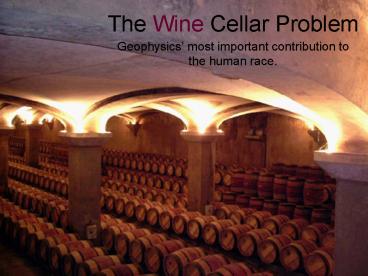The Wine Cellar Problem PowerPoint PPT Presentation
Title: The Wine Cellar Problem
1
The Wine Cellar Problem
- Geophysics most important contribution to the
human race.
2
The Situation
x
?
z
3
Questions
- What is the temperature anomaly as function of
time, depth and the Fourier transform of qs(t)? - What constants determine the attenuation depth of
the temperature anomaly? - What is the attenuation depth of the periodic
temperature variations due to the - Diurnal cycle?
- Annual cycle?
- Glacial cycle?
4
Assumptions
- The ground is a semi-infinite homogenous
half-spaceso we use the 1-D, time dependent heat
conducting equation - Constant thermal properties (k, k)
- As z gt infinity the temperature T(z,t) gt To,
where To is the average surface temperature - which means were ignoring heat flux from the
mantle, and we have no internal heat sources - which essentially means the ground in question
is an isolated body
5
Deriving the Temperature Anomaly
- If qs(t) is a periodic forcing function we can
assume it is of the form . So the
differential equation at the surface becomes - Because the heat flux is periodic and the PDE is
linear we can guess the solution has the form
6
Deriving the Temperature Anomaly
- Substituting T(z,t) into the diffusion equation
we get - Which reduces to a 2nd order linear ODE
- Which has the well known general solution
7
Still Deriving
- Because were interested in the exponential decay
with increasing depth, we let a 0, then select
the second term and plug f(z) back into T(z,t) to
get
8
Still Deriving
- And after separating out the oscillatory part
9
But what about A?
- Apply the boundary condition at the surface
- If we sub T(z,t) into this bad boy we get
10
And so our super final answer is
11
Finally, compare T(z,t) with q(s)
- There is a difference of ?/4 between the
oscillatory parts of these two functions
See the extra ?/4?
meaning that the temperature anomaly at any
given depth will lag behind the surface
fluctuation by 1/8 of the period of the
fluctuation.
12
Attenuation Depth
- The depth at which the temperature has negligible
fluctuation w.r.t. the surface temp. In other
words where do we put our cellar?? - where
- Equate this to the temperature function
13
Attenuation Depth
- and solve for z!
- zo is only dependent on k and w
- So re-write the temperature function
14
So now what?
- We want to know how the attenuation depth will
vary with time and soil conditions - so we chose three time scales to examine
- w 2pf
- Diurnal w 7.27x10-5 rad/sec
- Annual w 1.99x10-7 rad/sec
- Glacial w 1.99x10-12 rad/sec
15
- and we chose three soil conditions to consider
Clay Soil, Sandy Soil, Rock
Clay Soil Sandy Soil Rock
k (W/m2/k) 0.25 0.30 2.90
k (x10-6 m2/s) 0.18 0.24 1.43
16
Diurnal Cycle
- Tiny attenuation depths!
Clay Soil Sandy Soil Rock
zo (meters) 0.07 0.08 0.20
17
Diurnal Cycle
18
Glacial Cycle
- Huge attenuation depths!
Clay Soil Sandy Soil Rock
zo (meters) 425 491 1199
19
Annual Cycle
- Practical attenuation depths!
Clay Soil Sandy Soil Rock
zo (meters) 1.35 1.55 3.79
20
Annual Cycle
- We selected a wine-bearing region with
substantial temperature fluctuations
Canandaguia, New York - NEW YORK CITY?! Get a rope.
- Annual DT 18 kelvin
- Were assuming that the average surface
temperature, To, is the optimum temperature for
storing wine 55ºF.
21
Canandaguia Clay Soil
22
Canandaguia Sandy Soil
23
Canandaguia Rock
24
Cheers!

